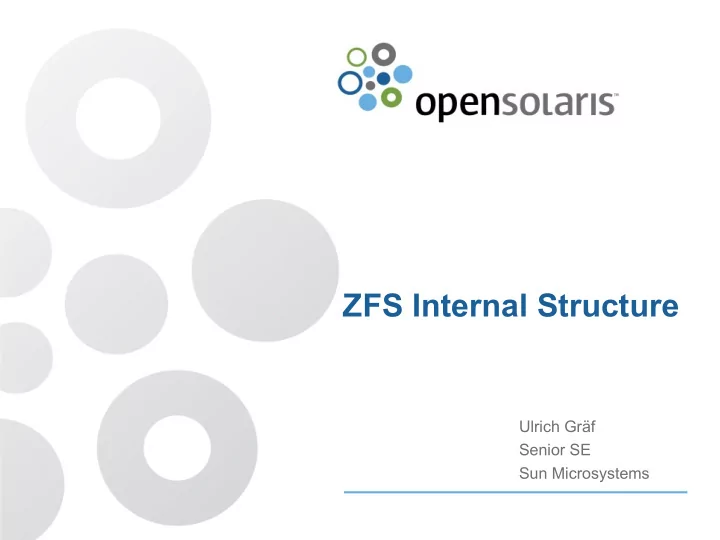

ZFS Internal Structure Ulrich Gräf Senior SE Sun Microsystems
ZFS – Filesystem of a New Generation Integrated Volume Manager Transactions for every change on the Disk Checksums for everything Self Healing Simplified Administration Also accelerated Changes online Performance through Controll of Datapath Everything new? No! But new in this combination!
Another explanation why using ZFS Current Trends in Datacenters Larger filesystems Data lives longer on disks Backup devices are sufficient Enough devices for Restore: Expensive Backups are complemented by copies on disk Copies on disks are more vulnerable to failures
ZFS and failures ZFS can correct structural errors caused by Bit errors ( 1 sectorin 10^16 reads) Errors caused by mis-positioning Phantom writes Misdirected reads Misdirected writes DMA parity errors Bugs in software and firmware Administration errors
ZFS Self Healing Elements: Integrated Volume Manager (Large!) Checksums inside of Block Pointer How does it work? Read a block determined by Block Pointer Create a checksum Compare it with checksum in Block Pointer On Error: use/compute block (redundancy) Structural Integrity (remember: Star Trek)
ZFS Self Healing Is different from other filesystems Is a quality not available from other filesystems Is only possible when combining Integrated Volume Manager Redundant Setup Large Checksums Is not available on Reiser*, ext3/ext4, WAFL, xfs Will be available on btrfs, when it is finished (but not all other ZFS features)
ZFS Self Healing Application Application Application ZFS mirror ZFS mirror ZFS mirror
ZFS Structure ZFS Structure: Uberblock Tree with Block Pointers Data only in leaves
ZFS Structure: vdev A ZFS pool (zpool) is built from Whole disks Disk partitions Files … called physical vdev
ZFS Structure: Configuration Configuration can be Single device Mirrored (mirror) RAID-5/RAID-6 (raidz, raidz2) Recently: raidz3 (raidz n is in planning)
ZFS: physical vdev Each physical vdev contains 4 vdev labels (256 KB each) 2 labels at the beginning 2 labels at the end A 3.5 MB hole for boot code 128kb blocks for data of the zpool L L H L L
ZFS: vdev label A vdev label contains 3 parts gap (avoid conflicts with disk labels) nvlist (name – value pair list) (128KB) Attributes of the zpool Including the configuration of the zpool uberblock array (128 entries, each 1KB) Configuration also defines logical vdevs mirror or raidz, log and cache devices
ZFS: nvlist in a vdev label (1) $ zdb -v -v data version=4 name='data' state=0 txg=162882 pool_guid=1442865571463645041 hostid=13464466 hostname='nunzio' vdev_tree ...
ZFS: nvlist in a vdev label (2) vdev_tree type='root' Id=0 guid=1442865571463645041 children[0] type='disk' id=0 guid=15247716718277951357 path='/dev/dsk/c1t0d0s7' devid='id1,sd@SATA_____SAMSUNG_HM251JJ_______S1J... phys_path='/pci@0,0/pci1179,1@1f,2/disk@0,0:h' whole_disk=0 metaslab_array=14 metaslab_shift=27 ashift=9 asize=25707413504 is_log=0
ZFS: uberblock Verification Magic number ( 0x00bab1oc ) for endianess Version Transaction Group number Time-stamp Checksum Content: Pointer to the root of the zpool tree
ZFS: uberblock: Example $ zdb -v -v data ... Uberblock magic = 0000000000bab10c version = 4 txg = 262711 guid_sum = 16690582289741596398 timestamp = 1256864671 UTC = Fri Oct 23 12:04:31 2009 rootbp = … ...
ZFS: block pointer Data virtual address (1, 2 or 3 dva) Points to other block References a vdev number defined in configuration Contains number of block in vdev Grid information (for raidz) Gang bit (“gang chaining” of smaller blocks) Type and size of block (logical, allocated) Compression information (type, size) Transaction group numer Checksum of block (dva points to this block)
ZFS: block pointer : Example rootbp = [L0 DMU objset] 400L/200P DVA[0]=<0:5c8087800:200> DVA[1]=<0:4c81a2a00:200> DVA[2]=<0:3d002ca00:200> fletcher4 lzjb LE Contiguous birth=262711 Fill=324 cksum=914be711d:3ab1cae4571 :c07d93434c9b:1ab1618a08eccd
ZFS: some block pointers in a zpool L L H L L L L H L L L L H L L
ZFS: Transactions 1. Starting at a consistent structure 2. Blocks may be changed by programs ● Only prepared in main memory ● Blocks are never overwritten on disk 3. Transaction is prepared ● Structure is completed up to the root block ● Blocks are written to vdevs ● Only free blocks are used 4. Transaction is committed ● The next uberblock slot is written
ZFS: Transaction
ZFS DMU Objects All data in a zpool is structured in objects dnode defines an object Type and size, indirection depth List of block pointers Bonus buffer (f.e. for standard file attributes) DMU object set Object that contains an array of dnodes Uberblock: points to the Meta Object Set
ZFS: Object Structure
ZFS: Intent Log Stores all synchronously written data Uses unallocated blocks Is rooted in the Object Set
ZFS: Dataset and Snapshot Layer DSL – Dataset and Snapshot Layer Filesystems Snapshots, clones ZFS volumes Meta Object Set contains Object Set and Number of DSL directory (ZAP object) Copy of the vdev configuration Blockpointers to be freed
ZFS: DSL Structure ZFS hierarchical names Child Dataset Entries in the DSL Directory Each Child has own DSL Directory DSL Dataset Implemented by a DMU dnode Snapshots and Clones Linked List rooted at the DSL Dataset
ZFS: DSL Structure
ZFS Attribute Processor ZAP – ZFS Attribute Processor Name / value pairs Hash table with overflow lists Used for Directories ZFS hierarchical names ZFS attributes
ZFS microZAP / FatZAP microZAP One block (up to 128k) Simple Attributes (64 bit number) Name length limited (50 bytes) FatZAP Object Hash into Pointer Table Pointers go to Name/Value storage
ZFS Posix Layer / Volume ZFS Posix Layer Implements a Posix filesystem with objects Directories are ZAP objects Files are DMU objects Additional: Delete Queue ZFS Volume Only one object in DSL Object set the Volume
ZFS: Misc Data is compressed when specified Metadata is compressed by default All internal nodes ZAP DSL Directories, DSL Datasets Copies are implemented with DVA in BP Zpool data is stored in 3 copies ZFS data is stored in 2 copies Data can be stored in up to 3 copies
ZFS Internal Structure Questions?
Recommend
More recommend